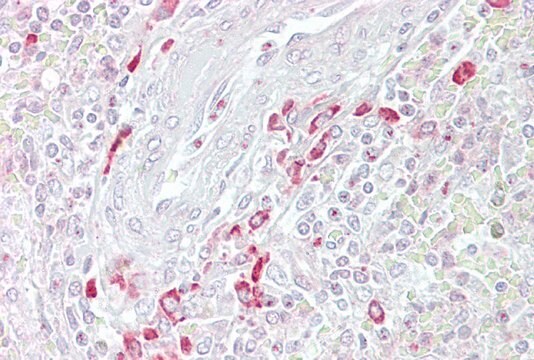詳細
We are committed to bringing you greener alternative products, which adhere to one or more of The 12 Principles of Green Chemistry.This antibody is Preservative-free, produced without the harm or sacrifice of animals and exceptionally stable to allow for ambient shipping and storage if needed and thus aligns with "Waste Prevention", "Designing Safer Chemicals" and "Design for Energy Efficiency".
Click here for more information.
ZooMAb® antibodies represent an entirely new generation of recombinant monoclonal antibodies. Each ZooMAb® antibody is manufactured using our proprietary recombinant expression system, purified to homogeneity, and precisely dispensed to produce robust and highly reproducible lot-to-lot consistency. Only top-performing clones are released for use by researchers. Each antibody is validated for high specificity and affinity across multiple applications, including its most commonly used application. ZooMAb® antibodies are reliably available and ready to ship when you need them.
特異性
Clone 1J11 is a ZooMAb® rabbit recombinant monoclonal antibody that specifically detects ATP-binding cassette transporter 1 (ABCA1). It targets an epitope within 16 amino acids from the C-terminal region.
免疫原
KLH-conjugated linear peptide corresponding to 16 amino acids from the C-terminal region of human ATP-binding cassette transporter 1 (ABCA1).
アプリケーション
Quality Control Testing
Evaluated by Immunohistochemistry (Paraffin) in Human liver tissue sections.
Immunohistochemistry (Paraffin) Analysis: A 1:100 dilution of this antibody detected ABCA1 in Human liver tissue sections.
Tested Applications
Affinity Binding Assay: A representative lot of this antibody bound ABCA1 with a KD of 2.7 x 10-7 in an affinity binding assay.
Western Blotting Analysis: A 1:10,000 dilution from a representative lot detected ABCA1 in Mouse liver tissue lysate.
Flow Cytometry Analysis: 0.1 μg from a representative lot detected ABCA1 in one million HepG2 cells.
Immunocytochemistry Analysis: A 1:100 dilution from a representative lot detected ABCA1 in HepG2 cells.
Note: Actual optimal working dilutions must be determined by end user as specimens, and experimental conditions may vary with the end user.
ターゲットの説明
Phospholipid-transporting ATPase ABCA1 (UniProt: O95477; also known as EC:7.6.2.1 1 , ATP-binding cassette sub-family A member 1, ATP-binding cassette transporter 1, ABC-1, ATP-binding cassette 1, Cholesterol efflux regulatory protein) is encoded by the ABCA1 (also known as ABC1, CERP) gene (Gene ID: 19) in human. ABCA1 is a multi-pass membrane protein with fifteen transmembrane domains and two extracellular domains (aa 43-639 and 1372-1656). It has two ABC transporter domains (aa 899-1131 and 1912-2144) and two ATP binding sites (aa 933-940 and 1946-1953). ABCA1 is widely expressed but is most abundant in macrophages. It is considered as a key gatekeeper influencing intracellular cholesterol transport. It catalyzes the translocation of specific phospholipids from the cytoplasmic to the extracellular/lumenal leaflet of membrane coupled to the hydrolysis of ATP. It participates in phospholipid transfer to apolipoproteins to form nascent high-density lipoproteins (HDL). It transports preferentially phosphatidylcholine over phosphatidylserine. Mutations in ABCA1 gene have been linked to Tangier disease, an autosomal recessive disorder that is characterized by near absence of plasma high density lipoproteins, low serum HDL cholesterol, and massive tissue deposition of cholesterol esters. ABCA1 is constitutively phosphorylated in RAW macrophages and in a human embryonic kidney cell expressing ABCA1. Phosphorylation of ABCA1 on serine 1042 and 2054 is mediated by protein kinase A. Phosphorylation on serine 2054 is reported to regulate phospholipid efflux. This ZooMAb® recombinant monoclonal antibody, generated by our propriety technology, offers significantly enhanced specificity, affinity, reproducibility, and stability over conventional monoclonals. (Ref.: Quazi, F., and Molday, RS (2013). J. Biol. Chem. 288(48); 34414-34426; See, RH., et al. (2002). J. Biol. Chem. 277(44); 41835-41842; Marcil, M., et al. (1999). Lancet. 354(9187); 1341-1346).
物理的形状
Purified recombinant rabbit monoclonal antibody IgG, lyophilized in PBS, 5% Trehalose, normal appearance a coarse or translucent resin. The PBS/trehalose components in the ZooMAb formulation can have the appearance of a semi-solid (bead like gel) after lyophilization. This is a normal phenomenon. Please follow the recommended reconstitution procedure in the data sheet to dissolve the semi-solid, bead-like, gel-appearing material. The resulting antibody solution is completely stable and functional as proven by full functional testing. Contains no biocide or preservatives, such as azide, or any animal by-products. Larger pack sizes provided as multiples of 25 μL.
再構成
300 μg/mL after reconstitution at 25 μL per vial. Please refer to guidance on suggested starting dilutions and/or titers per application and sample type.
保管および安定性
Recommend storage of lyophilized product at 2-8°C; Before reconstitution, micro-centrifuge vials briefly to spin down material to bottom of the vial; Reconstitute each vial by adding 25 μL of filtered lab grade water or PBS; Reconstituted antibodies can be stored at 2-8°C, or -20°C for long term storage. Avoid repeated freeze-thaws.
法的情報
ZooMAb is a registered trademark of Merck KGaA, Darmstadt, Germany
免責事項
Unless otherwise stated in our catalog or other company documentation accompanying the product(s), our products are intended for research use only and are not to be used for any other purpose, which includes but is not limited to, unauthorized commercial uses, in vitro diagnostic uses, ex vivo or in vivo therapeutic uses or any type of consumption or application to humans or animals.

